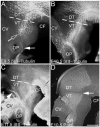Pax6 guides a relay of pioneer longitudinal axons in the embryonic mouse forebrain
- PMID: 15514979
- PMCID: PMC2080865
- DOI: 10.1002/cne.20317
Pax6 guides a relay of pioneer longitudinal axons in the embryonic mouse forebrain
Abstract
We have characterized a system of early neurons that establish the first two major longitudinal tracts in the embryonic mouse forebrain. Axon tracers and antibody labels were used to map the axon projections in the thalamus from embryonic days 9.0-12, revealing several distinct neuron populations that contributed to the first tracts. Each of the early axon populations first grew independently, pioneering a short segment of new tract. However, each axon population soon merged with other axons to form one of only two shared longitudinal tracts, both descending: the tract of the postoptic commissure (TPOC), and, in parallel, the stria medullaris. Thus, the forebrain longitudinal tracts are pioneered by a relay of axons, with distinct axon populations pioneering successive segments of these pathways. The extensive merging of tracts suggests that axon-axon interactions are a major guidance mechanism for longitudinal axons. Several axon populations express tyrosine hydroxylase, identifying the TPOC as a major pathway for forebrain dopaminergic projections. To start a genetic analysis of pioneer axon guidance, we have identified the transcription factor Pax6 as critical for tract formation. In Pax6 mutants, both longitudinal tracts failed to form due to errors by every population of early longitudinal axons. Taken together, these results have identified potentially important interactions between series of pioneer axons and the Pax6 gene as a general regulator of longitudinal tract formation in the forebrain.
Figures






Similar articles
-
Cortical and thalamic axon pathfinding defects in Tbr1, Gbx2, and Pax6 mutant mice: evidence that cortical and thalamic axons interact and guide each other.J Comp Neurol. 2002 May 20;447(1):8-17. doi: 10.1002/cne.10219. J Comp Neurol. 2002. PMID: 11967891
-
Pax-6 functions in boundary formation and axon guidance in the embryonic mouse forebrain.Development. 1997 May;124(10):1985-97. doi: 10.1242/dev.124.10.1985. Development. 1997. PMID: 9169845
-
R-cadherin is a Pax6-regulated, growth-promoting cue for pioneer axons.J Neurosci. 2003 Oct 29;23(30):9873-80. doi: 10.1523/JNEUROSCI.23-30-09873.2003. J Neurosci. 2003. PMID: 14586016 Free PMC article.
-
The role of Pax6 in forebrain development.Dev Neurobiol. 2011 Aug;71(8):690-709. doi: 10.1002/dneu.20895. Dev Neurobiol. 2011. PMID: 21538923 Review.
-
Molecular mechanisms in the formation of the medial longitudinal fascicle.J Anat. 2007 Aug;211(2):177-87. doi: 10.1111/j.1469-7580.2007.00774.x. Epub 2007 Jul 9. J Anat. 2007. PMID: 17623036 Free PMC article. Review.
Cited by
-
Interaction between axons and specific populations of surrounding cells is indispensable for collateral formation in the mammillary system.PLoS One. 2011;6(5):e20315. doi: 10.1371/journal.pone.0020315. Epub 2011 May 20. PLoS One. 2011. PMID: 21625468 Free PMC article.
-
Characterization of a mammalian prosencephalic functional plan.Front Neuroanat. 2015 Jan 6;8:161. doi: 10.3389/fnana.2014.00161. eCollection 2014. Front Neuroanat. 2015. PMID: 25610375 Free PMC article. Review.
-
Midbrain dopaminergic axons are guided longitudinally through the diencephalon by Slit/Robo signals.Mol Cell Neurosci. 2011 Jan;46(1):347-56. doi: 10.1016/j.mcn.2010.11.003. Epub 2010 Nov 27. Mol Cell Neurosci. 2011. PMID: 21118670 Free PMC article.
-
Notch signaling and proneural genes work together to control the neural building blocks for the initial scaffold in the hypothalamus.Front Neuroanat. 2014 Dec 2;8:140. doi: 10.3389/fnana.2014.00140. eCollection 2014. Front Neuroanat. 2014. PMID: 25520625 Free PMC article. Review.
-
Pαx6 expression in postmitotic neurons mediates the growth of axons in response to SFRP1.PLoS One. 2012;7(2):e31590. doi: 10.1371/journal.pone.0031590. Epub 2012 Feb 16. PLoS One. 2012. PMID: 22359602 Free PMC article.
References
-
- Andrews GL, Yun K, Rubenstein JL, Mastick GS. Dlx transcription factors regulate differentiation of dopaminergic neurons of the ventral thalamus. Mol Cell Neurosci. 2003;23:107–120. - PubMed
-
- Auladell C, Perez-Sust P, Super H, Soriano E. The early development of thalamocortical and corticothalamic projections in the mouse. Anat Embryol (Berl) 2000;201:169–179. - PubMed
-
- Bagri A, Marin O, Plump AS, Mak J, Pleasure SJ, Rubenstein JL, Tessier-Lavigne M. Slit proteins prevent midline crossing and determine the dorsoventral position of major axonal pathways in the mammalian forebrain. Neuron. 2002;33:233–248. - PubMed
Publication types
MeSH terms
Substances
Grants and funding
LinkOut - more resources
Full Text Sources
Molecular Biology Databases

